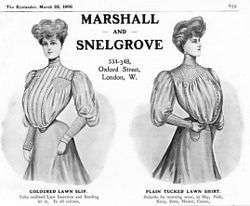Marshall & Snelgrove
Marshall & Snelgrove was a department store on the north side of Oxford Street, London, on the corner with Vere Street founded by James Marshall (b.? Yorkshire – d.22 November 1893). The company is now part of Debenhams.

History
In 1837 James Marshall, a Yorkshireman, opened a shop at 11 Vere Street in partnership with a Mr Wilson. Marshall had previously worked as a shop assistant for Burrell, Son and Toby at 10 Vere Street.[1] The partnership expanded to become Marshall, Wilson and Stinton. In 1848 when Stinton retired, John Snelgrove, an assistant in the business, became a partner and the firm's name was changed to Marshall and Snelgrove. In 1847 James C Marshall, eldest son of James Marshall, joined the firm. The business expanded and new premises were taken on the corner of Vere Street and Oxford Street. The new building opened in 1851 and was originally called the Royal British Warehouse.
In 1855 James C Marshall married Louisa Stinton, daughter of the partner who had retired.
In 1871 James Marshall, the founder, retired with the firm then being run by James C Marshall and John Snelgrove. Snelgrove died in 1903.
Branches were opened in the then fashionable resorts of Scarborough, Harrogate and elsewhere.[1]
The First World War had great impact on department stores especially the luxury market. By 1916 a working relationship was established with Debenhams in order to preserve the businesses in the war economy. There was a full merger in May 1919 when Marshall and Snelgrove had financial difficulties.[2]
James C Marshall was President of the Linen and Woollen Drapers' Institution for almost 40 years till his death in 1925 at the age of 95.
Members of the Marshall family remained at the helm of the business. Further branches were established as a number of stores were added to the Marshall & Snelgrove nameplate. These included stores in Birmingham (formerly Warwick House), Manchester (opened 1938; closed 1969),[3] Southport, Leicester (formerly Adderleys), Leeds, York, Sheffield and Bradford.
The Oxford Street store was demolished and rebuilt between 1973–79,[1] and opened as the Debenhams flagship store. All other Marshall & Snelgrove stores were rebranded.
References
Further reading
- Settle, Alison (1951). A Family of Shops: Marshall & Snelgrove. Privately published.